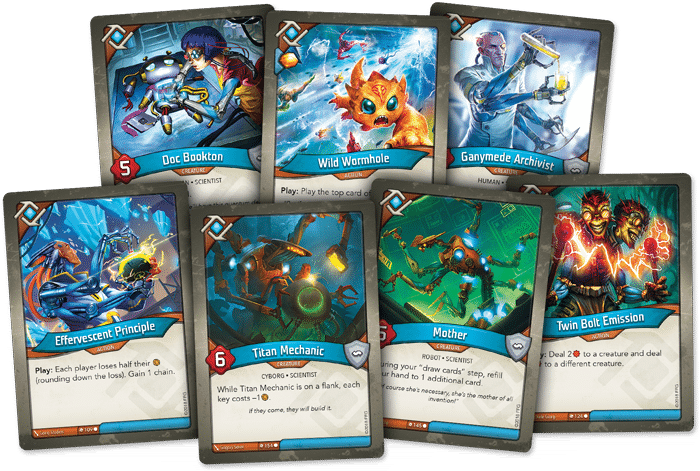Hello, Keyforgers! Having introduced you to the gnitty gritty of each House in the Keyforge card game, now is a good time to take a look at all the Houses together, and get a real nice look at the Keyforge neighborhood as a whole.
In each of the Open House articles (which will be linked with each House below), I did an overview of the House’s lore as well as their strengths and weaknesses. At first we looked at each of the Houses in isolation, in order to bring out what made each House unique. Now let’s focus on how the Houses work with one another.
Every deck in Keyforge consists of three of the seven Houses–Mars, Untamed, Dis, Sanctum, Logos, Brobnar, and Shadows–so in reality these Houses are always working together (whether they like to or not).
So, what I’m going to do is break each House down. First, I’m going to give my personal thoughts on them, and then go into what role I typically see them playing in games. Finally, I’m going to provide a rating of 1-10 of how well they perform with the different mechanical elements of Keyforge.
The mechanical elements I’m rating are:
- Battleline Presence,
- Battleline Control,
- Aember Gain,
- Aember Control,
- Player Control, and
- Card Advantage.
Many of these terms have been appropriated from the general card game sphere, but they’re worth going into so that you’ll know what I’m talking about.
Battleline Presence is what I refer to as your position on the battleline. Many creatures provide a major advantage by being on the battleline, and many decks benefit from having a battleline filled with creatures and artifacts.
A House’s Battleline Presence will measure how well that House is at getting things onto the battleline as well as how good of a job it does at keeping them there, plus how flexible it is at using the things on its battleline to its full advantage.
Battleline Control is what I refer to as your ability to shape the battleline to your strategy. In most cases this will include a House’s ability to remove creatures or artifacts from the opponent’s battleline either by outright destroying/purging them, attacking them with creatures, or by exhausting/stunning them.
Aember Gain is what I refer to as your ability to gain aember, whether through creatures or through other means. It is perhaps the most straightforward, but one of (if not the) most important aspects of Keyforge since you need aember in order to win (as if you didn’t know that by now!).
Aember Control is what I refer to as your ability to limit your opponent’s aember gains by either stealing from them, destroying their aember or capturing it.
Player Control is what I refer to as your ability to limit what your opponent can do on their turn by completely preventing them from doing certain actions.
And, finally, Card Advantage is what I refer to as your ability to access new cards or cards you wouldn’t normally be able to access. I will also be including any cards that let you take control of or use the opponent’s cards in this as well, since it opens the options you have at your disposal.
And with that, let’s stroll through the neighbourhood one more time and take a look at our lovely Houses!
 Keyforge: House Sanctum
Keyforge: House Sanctum
Sanctum is like your friendly neighbourhood veteran. He’s old, sweet, and loves to talk your ear off with his cool war stories that you’ve heard a thousand times before. He’s predictable, but dependable, even if he needs some help from time to time with things. He’ll always pay you with a butterscotch or even slip you a ten.
That’s how I feel about Sanctum. Old, reliable, but sometimes too predictable. Sanctum can hold its own in a fight with well armored and tanky creatures, and can snatch up aember to give you much needed time to storm those aember trenches, but old Sanctum’s golden days are in the past and he won’t be winning any games on his own.
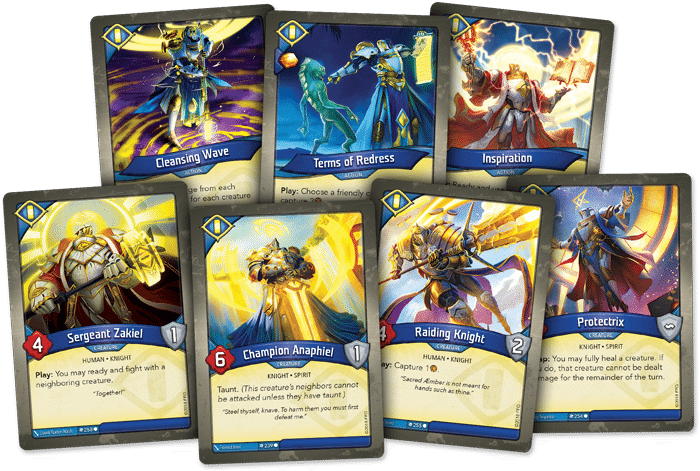
Sanctum: Role –Support / Control
I view Sanctum as a pretty defensive House. It can hold up a fight with its creatures, but they’re generally better suited to protect other creatures on the field with their high armor and taunt abilities.
If I need to keep something alive on the field, I sure as hell want to have Sanctum at my side because they are the kings of protecting and healing. When they’re not doing that, they do have a number of options of keeping aember away from your opponent in the form of the many creatures and action cards that can capture aember.
They have a little bit in the way of generating aember (shout out to Virtuous Works and Cleansing Wave) but just like the old veteran, you’ll likely need to rely on your other Houses to really get your aember.
Sanctum: Ratings
Battleline Presence: 10/10 – Sanctum has one of the best (if not the best) ability to protect your assets on the battleline, no doubt about it. They also have a decent flexibility in allowing you to use creatures from other Houses.
Battleline Control: 6/10 – Sanctum can hold a fight on the battleline, and have some tools to destroy creatures and artifacts, as well as the ability to purge a few things, as well as stunning others. Some Houses perform better, but Sanctum is hardly a slouch in this department.
Aember Gain: 3/10 – More concerned with capturing aember than gaining it, Sanctum is not great in this department but a few decently powerful cards like Virtuous Works and Cleansing Wave stop it from completely failing.
Aember Control: 8/10 – This is one of Sanctum’s better strengths. They have a consistent supply of cards that allow you to capture aember, and since Sanctum creatures are no slouches it is likely they’ll be holding on to that aember for a little while.
Player Control: 1/10 – There’s not much Sanctum has in the way of limiting your opponent’s options. The Vaultkeeper is the only fellow I see who does anything close to that by preventing your opponent from stealing from you. Powerful card, but this is clearly not Sanctum’s domain.
Card Advantage: 2/10 – Again, there’s not much Sanctum has in the way of accessing more cards or your opponent’s cards. The potent synergy between the Horsemen, particularly Horsemen of Death, does net it some points in this department, but only a few.
Click here for a deep dive into the cards and strategy of Sanctum.
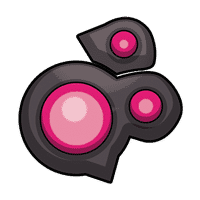 Keyforge: House Dis
Keyforge: House Dis
If Sanctum is the old kindly war veteran, Dis is the grumpy old dude who yells at people to get off his lawn. Never sure what to think of him, you nevertheless know you sure as hell don’t want to be around him. And if you decide to fight back? Well you might wake up one day with your tires slashed.
Dis is a House I often fear facing as much as I love having it in my deck. It is a House you want to stay away from when facing it. Or short of avoiding it, you’ll definitely need to prepare for it.
Dis: Role –Control
Dis is definitely all about control. They have some of the most dastardly ways of limiting your opponent. A very aggressive House, Dis is all about proactively trying to sabotage your opponent’s plans.
Your mileage with Dis depends very much on your skill as a Keyforge player. If you are observant you can use Dis to great effect, but their effectiveness can be greatly diminished if you manage to overlook or misread the big picture.
Dis: Ratings
Battleline Presence: 4/10 – While Dis has access to a number of meaty mid-ranged creatures, and the very utilitarian Dominator Bauble, most of the good stuff Dis has on the battleline are its creatures that provide elements of control, which are sadly pretty easily killed (such as Ember Imp and Succubus).
Battleline Control: 8/10 – Dis is great at killing creatures, as well as bouncing creatures from the battleline back into the hand.
Aember Gain: 5/10 – Dis are not terrible at gaining aember, but neither is it their specialty. Tolas and Dust Imp are decent bread winners though.
Aember Control: 7/10 – Dis have a pretty sizable arsenal of Aember Control cards at their disposal such as Lash of Broken Dreams and Drumble, who can come in at pretty pivotal moments in a game.
Player Control: 10/10 – Oh boy, Dis are nasty in this department. No other House comes even close to limiting a player’s options of what they can and cannot do on their turn as Dis does.
They can force your House with Control the Weak, prevent you from choosing another House with Restringuntus, decrease how much you can draw with Succubus and how much you can play with Ember Imp. And geez, that’s not even all that they can do! It’s bonkers, I tell you!
Card Advantage: 8/10 – Dis has a pretty nasty streak of swiping control of creatures with Collar of Subordination and Overlord Greking, as well as the very potent Arise!
Click here for a deep dive into the cards and strategy of Dis.
 Keyforge: House Untamed
Keyforge: House Untamed
Fittingly, if I had to characterize Untamed, I would say it’s the neighborhood stray. Stray cat, stray dog, stray goose, you take your pick. But it’s that lovable animal that everyone knows, and wants to take care of. Everyone’s always happy to see it, and everyone wants to stop and pet it.
Wherever it goes, Untamed is always welcome. I am always happy when I see that the Untamed icon on the back of my cards. I know that whatever Untamed gives me, I’ll be able to make good use out of it.
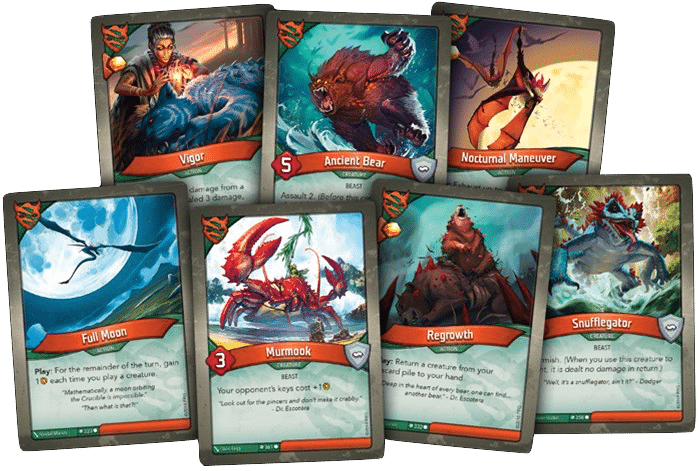
Untamed Role –Offense / Achieving Victory
While Sanctum is great at supporting the other Houses and Dis is great at holding your opponent back, neither of those strategies will guarantee you a win.
Untamed, on the other hand? It is a House that can win you the game. Singlehandedly, even (if with a little bit of effort). With ways of generating a steep amount of aember, setting up a decent battleline, and blitz-forging some keys, Untamed has your back and will (more likely than not) carry you to victory.
Untamed: Ratings
Battleline Presence: 8/10 – With a horde of vicious creatures, as well as access to the Skirmish ability, Untamed is a pack of wild creatures let alone major assets like the nigh unkillable Ancient Bear (when paired with Bear Flute), and the versatile Witch of the Wilds, Untamed is a force to be reckoned with here.
Battleline Control: 7/10 – Having access to Skirmish lends Untamed creatures the ability to aggressively hunt down other creatures with no retribution. When not hunting, Nocturnal Manuever and Bigtwig can slow the opponent’s creatures down really well.
Aember Gain: 10/10 – Untamed is a veritable juggernaut when it comes to generating raw aember. Fertility Chant, Giant Sloth and Dew Faerie are all contenders for the best aember generators, and you have the power of Full Moon and Hunting Witch to generate even more. Untamed is definitely at the head of the pack in terms of getting that sweet, sweet aember.
Aember Control: 3/10 – While it can generate aember, Untamed isn’t too concerned with containing it. It has a few options to steal with Lifeweb and Stampede, but they have clunky conditions that aren’t always easy to fulfill.
Player Control: 2/10 – Not having too much in this department, Untamed has Fogbank which is a pretty useful card.
Card Advantage: 9/10 – If they weren’t the best at aember generation, this would be next in line of what Untamed is good at. This comes mostly in the form of recycling cards from the discard pile by way of Nepenthe Seed, Witch of the Eye, and World Tree.
Though Dis’s Arise! may have more bang, Untamed is a fair deal more reliable at getting stuff back from the ground. Oh, and Untamed has Mimicry too, which is basically my favourite card in terms of versatility.
Click here for a deep dive into the cards and strategy of Untamed.
 Keyforge: House Brobnar
Keyforge: House Brobnar
This may be a little too obvious, but Brobnar is the neighbourhood drunk. Not sure what to do with itself, but always wanting to stir up trouble and prove how big they are.
And that breath? Utterly terrible. Each time you come across them, you know what to expect and it’s best to step out of the way and let them cause their ruckus. You can always clean up later.
Basically, just let Brobnar be Brobnar. That’s how Brobnar wants it, and it’s better if you don’t get in the way.
Brobnar Role –Offense
If there is anything Fantasy Flight Games (FFG; maker of Keyforge) wants you to know is that Brobnar likes to fight. I could probably leave it at that, and that would be all you would need to know to get the gist of what Brobnar is all about.
Having spent some quality time with Brobnar, however, I have found that there is a certain finesse in using their aggression to shape how the game plays out to your advantage. Of course you are primarily going to be using these guys to fight the opponent, and probably little else.
Brobnar: Ratings
Battleline Presence: 10/10 – Unsurprisingly, Brobnar is strong here. Brobnar has the most consistently beefy creatures, as well as having the most cards that allow other Houses join the fray.
One of Brobnar’s strengths is getting their creatures readied and able to fight (often multiple times in a single turn). Brobnar moves hard, and they move fast.
Battleline Control: 9/10 – And just as they moving, they are fighting. Brobnar is just itching to clobber the enemy and they have a wealth of creatures, artifacts and actions that are eager to deal damage to the enemy.
Aember Gain: 6/10 – Though no experts at gaining aember, Brobnar can get a decent chunk of the stuff when the fight gets going. In particular Loot the Bodies, Warsong and The Warchest make for some decent plays, if you have a good fight going.
Aember Control: 6/10 – Brobnar likes wrecking stuff, and to no one’s surprise that also includes wrecking aember. Though inferior (in my opinion) to stealing, they’re good to have around if the opponent is getting too far ahead.
Player Control: 0/10 – Interested in keeping the fight interesting, Brobnar doesn’t hold back and neither does it hold back the opponent.
Card Advantage: 1/10 – Brobnar has Sound the Horns, which can either get you a creature into play or cycle through your deck, but that’s basically it for them.
Click here for a deep dive into the cards and strategy of Brobnar.
 Keyforge: House Logos
Keyforge: House Logos
Logos would likely be our neighbourhood kook. A little eccentric, but obviously extremely knowledgable. They’ll talk your ear off about cats in boxes and all the while you feel like you’re the dumb one.
You never quite know what you’ll get with Logos. One day they’ll be showing off a neat robo-cat, and the next their house has been sucked into another dimension. It’s always a journey with Logos.
Logos Role – Support
Logos is all about offering new options and opportunities. This mostly takes the form of expanding the options available, by either letting you draw more cards or allowing you to archive certain cards for later.
Logos is a thinking person’s House. You’ll want to make use of the different strengths of Logos to formulate a long-term plan for your game. And when in doubt, you can also use their whacky experiments to blow everything up to high heavens and start the whole thing over again.
Logos: Ratings
Battleline Presence: 3/10 – There’s nothing Logos has to throw on the battleline that is too terrifying, though Titan Mechanic and Mother both provide some seriously good benefits and both are decently tanky enough to hold their own.
Battleline Control: 7/10 – Logos is really, really good at blowing everything up, and fall just short of Dis’s ability to consistently wipe things out. This is mostly because Logos also blows up its own stuff as well as the opponent’s, so it falls a little behind in this department but not by much.
Aember Gain: 3/10 – Logos doesn’t have much in the way of generating aember. It’s clear their focus lies elsewhere.
Aember Control: 5/10 – Logos is pretty decent here. They don’t have a grand arsenal of aember control cards, but they have some doozies in the form of Dimension Door and Effervescent Principle.
Player Control: 7/10 – While falling short of Dis, Logos still has a few really strong options of limiting the opponent in the form of Skippy Timehog (who is bonkers good), Foggify (mirroring Untamed’s Fogbank), and Scrambler Storm.
Card Advantage: 10/10 – This is Logos’ domain by far. Want to draw cards? Check. Want to Archive them for later? Check. Want to “borrow” the opponent’s artifacts? Here’s Remote Access. Also has a meta-defining card called Library Access. No big deal.
Click here for a deep dive into the cards and strategy of Logos.
 Keyforge: House Shadows
Keyforge: House Shadows
Shadows is Little Orphan Annie if Annie had sticky fingers. She’s the cute adorable ragamuffin that wanders the streets and no one actually knows if she has parents or not. She seems innocent at first, until you notice your wallet is missing.
Shadows looks easy to underestimate but then three turns later they’ve stolen all of your aember and have already won the game.
Shadows Role – Achieving Victory
Ironically, for a faction that are all skulky thieves lurking the shadows, Shadows is the House that I describe as the star quarterback of the game. In a game like Keyforge where acquiring aember is the end goal (and not the complete annihilation of your foe), Shadows is the House that is most concerned with that victory objective.
Shadows can steal aember like it’s going out of style, but it can also generate a fair bit too. I would make the bold statement in saying that entire games could be won simply using Shadows alone, that’s how good they are at going for the victory condition of this game.
Shadows: Ratings
Battleline Presence: 5/10 – While much of Shadows’ creatures aren’t very strong and are pretty squishy, they are also pretty darn hard to hit given that so many of them have Elusive, and also have Shadow Self to soak up any damage from anything you might want to protect.
They also have Speed Sigil and Evasion Sigil which gives them an edge on the battleline that you wouldn’t expect.
Battleline Control: 4/10 – Though not completely useless in this department, Shadows doesn’t have too too much in the ways of killing creatures or removing artifacts. They have Macis Asp and Mooncurser who are decent assassins, and a handful of damage dealing cards. But you can leave the Battleline Control for the other Houses better suited for it.
Aember Gain: 8/10 – Shadows is definitely among the forerunners in getting their hands on aember. Most of the time this is done by stealing, but they also have a few juicy aember gain cards like Ghostly Hand and Treasure Map.
Aember Control: 10/10 – This is where Shadows (ironically) shines. By stealing so much aember, not only do they gain it themselves but they also deprive the opponents of it, so their sticky fingers does double duty.
Shout outs to the ever beloved Too Much to Protect and Bait and Switch, the latter being a card that can easily win games by itself.
Player Control: 6/10 – While not outright limiting the opponent like Dis and Logos can, Shadows does have a few cards that punish players or deprives them of opportunities. Miasma is a great staller, preventing the opponent from forging a key. Customs Office makes it costly for the opponent to play artifacts, and Evasion Sigil makes it hard for anyone to attack.
Card Advantage: 6/10 – Shadows has some crafty tricks. Though they’re outshone by Untamed, Logos and even Dis in this department, Shadows can nab a few extra cards here and there by archiving with Hidden Stash, having Smiling Ruth dominate an opponent’s creature or Nexus fiddling around with the opponent’s artifacts.
Shout out to the super flexible Masterplan as well who’ll let you bust out an ace in the hole when you really need it.
Click here for a deep dive into the cards and strategy of Shadows.
 Keyforge: House Mars
Keyforge: House Mars
Mars is the rat-infested roadkill on the side of the street that you’ve been calling animal control for weeks now and they haven’t sent anyone yet. Everyone dreads nearing it. The rats with their beady little eyes sneer and growl at you. They are getting fiercer by the day. And you know in your heart of hearts that they are up to something.
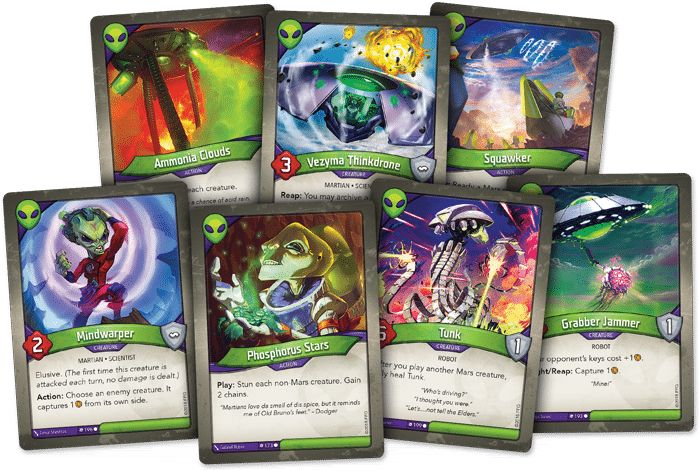
Mars Role – Versatile
Mars can do pretty much anything. The gimmick of Mars is that they work best in conjunction with other Mars cards. Depending on what you get in your deck, you might have Mars in the role of Control or Support, or if you have the beloved “John Smyth” and Uliq Megamouth, you can generate a juicy amount of aember.
In a sense, the Empire of Mars is a jack of all trades.
Mars: Ratings
Battleline Presence: 10/10 – There are few things I’m genuinely afraid of in this game, and a whole battleline filled with Mars creatures is one of them. So many of their cards synergize with Mars-creatures on the battleline, so the more of them you have, the more devestating their oncoming onslaughts will be.
Also, between Tunk, Yixilx Dominator and Chuff Ape we have some vertiable juggernauts here.
Battleline Control: 7/10 – Mars has a hefty war machine to bring to bear on the battleline as well. Yxilo Bolter and Mothergun are solid mainstays in blasting creatures off the field. They also have a decent way of stunning creatures with Squawker and Phosphorus Stars.
Also, Mars loves abducting creatures into their archives with Uxlyx the Zookeeper and Sample Collection.
Aember Gain: 5/10 – While not the main focus of Mars’ efforts, Mars is still capable of raking in the aember. Crystal Hive, Total Recall, and Mating Season are capable of generating some decent aember.
Aember Control: 8/10 – Running neck and neck with Shadows, Mars is also capable of locking down aember. Mindwarper and Yxili Marauder are great at scooping up aember, as well as one of my favourite cards Grabber Jammer who does that and makes keys more expensive for your opponent. There’s also Shatter Storm for fun aember destroying nonsense.
Oh, and I can’t forget about Ether Spider, the best aember vortex in the game.
Player Control: 1/10 – Mars is too busy destroying everything to focus on hampering down the player. Deep Probe is basically the only tool I see that helps limit the opponent.
Card Advantage: 6/10 – Though they don’t have too much at their disposal, Mars does have some pretty powerful cards. Battle Fleet can result in some crazy draws rivalling Library Access. Invasion Portal can either cycle through your deck or land you an extra Mars creature, while Incubation Chamber lets you archive some of your creatures. They’re no Logos, but they’re no slouches in this department either.
Click here for a deep dive into the cards and strategy of Mars.
And there we have it, Keyforgers. A tour of the glorious Keyforge neighbourhood. I hope you’ll stay awhile and really meet the neighbors (some of them are actually nice, I promise!).
For the time being this will be it for Open House, as it is our final viewing. Should there come a day when a new House joins the fray, I shall be back to meet the neighbors. Until then, happy forging!


